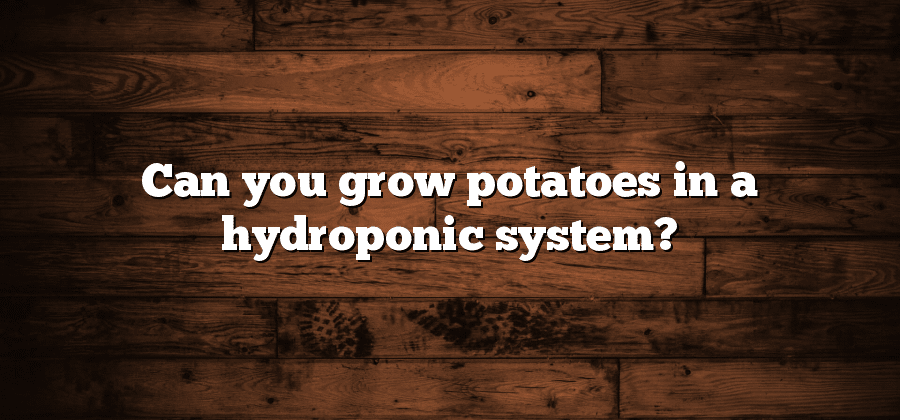Benefits of Hydroponic Potato Cultivation
Efficient use of resources is one of the significant benefits of hydroponic potato cultivation. Unlike traditional soil-based farming, hydroponics requires less water to grow potatoes. This is because the water in a hydroponic system is recycled and reused, eliminating the need for excessive irrigation. Additionally, hydroponics allows for precise control over nutrient delivery to the plants, resulting in less wastage and more efficient utilization. This method also eliminates the need for pesticides and herbicides, making hydroponic potatoes a healthier and safer choice for consumers.
Another advantage of hydroponic potato cultivation is the ability to grow potatoes year-round, regardless of seasonal limitations. With traditional farming methods, potatoes are typically grown in specific seasons when the soil and weather conditions are suitable. However, in hydroponics, potatoes can be grown in controlled environments, allowing farmers to produce high-quality potatoes consistently throughout the year. This means a more stable supply of fresh potatoes, which can help meet consumer demands and reduce dependence on imports. Additionally, the controlled environments of hydroponics reduce the risk of pests and disease, resulting in healthier and more productive potato crops.
Ideal Hydroponic Systems for Potatoes
There are several types of hydroponic systems that are suitable for growing potatoes. One commonly used system is the nutrient film technique (NFT). In this system, a thin film of nutrient-rich water flows through a sloping channel, and the plant roots are suspended in the film, allowing them to take up the necessary water and nutrients. NFT is a popular choice for potato cultivation because it provides excellent oxygenation to the roots and allows for easy monitoring and adjustment of nutrient solution levels.
Another hydroponic system that can be ideal for growing potatoes is the deep water culture (DWC) system. In a DWC system, the plant roots are suspended in a nutrient solution that is constantly aerated to provide adequate oxygen. This system is particularly suitable for potatoes as it allows the plants to develop strong and healthy root systems. The continuous supply of oxygen in the nutrient solution helps prevent root rot and promotes nutrient uptake, leading to vigorous growth and high-quality potato yields.
Choosing the Right Potato Varieties
When it comes to choosing the right potato varieties for hydroponic cultivation, there are several factors that should be taken into consideration. First and foremost, it is important to select varieties that are well-suited for indoor and controlled environments. These varieties should have a compact growth habit and be resistant to diseases commonly found in hydroponic systems.
In addition to being suitable for hydroponic conditions, the potato varieties should also have excellent taste, texture, and cooking qualities. Selecting varieties with these characteristics will ensure that you can enjoy a delicious and satisfying harvest. Furthermore, it is recommended to choose varieties that have a relatively short growing season, as this allows for multiple cropping cycles throughout the year. By carefully considering these factors, you can select potato varieties that will thrive in your hydroponic system and provide you with a bountiful harvest of high-quality potatoes.
Preparation of Hydroponic Potato System
A crucial step in setting up a successful hydroponic potato system is selecting the right location. Ideally, you should choose an area that receives ample sunlight throughout the day. This will help facilitate optimal growth and development of the potato plants. Additionally, ensure that the chosen location is well-ventilated to prevent any stagnant air or humidity build-up.
Next, it is essential to select the appropriate containers or pots for your potato plants. When it comes to hydroponics, various container options are available, such as buckets, grow bags, or specially designed hydroponic systems. Whichever container you choose, ensure that it has sufficient drainage holes to prevent waterlogging. Additionally, consider the size of the container as it should provide enough space for the potatoes to grow and expand their root system.
Nutrient Requirements for Hydroponic Potatoes
In hydroponic potato cultivation, providing the right nutrients is crucial for the proper growth and development of the plants. Potatoes require a balanced supply of essential macronutrients and micronutrients to thrive in a hydroponic system. These nutrients are necessary for promoting root growth, enhancing tuber formation, and increasing overall plant productivity.
The macronutrients needed for hydroponic potatoes include nitrogen (N), phosphorus (P), and potassium (K). Nitrogen is important for leaf growth and chlorophyll production, while phosphorus aids in root development and energy metabolism. Potassium plays a vital role in maintaining water balance within the plant and improving disease resistance. In addition to macronutrients, hydroponic potatoes also require micronutrients such as iron (Fe), manganese (Mn), and zinc (Zn), among others, in smaller quantities. These micronutrients are essential for various enzymatic processes and overall plant health. When supplying nutrients to hydroponic potatoes, it is important to ensure a proper balance to prevent deficiencies or toxicities that may hinder plant growth.






